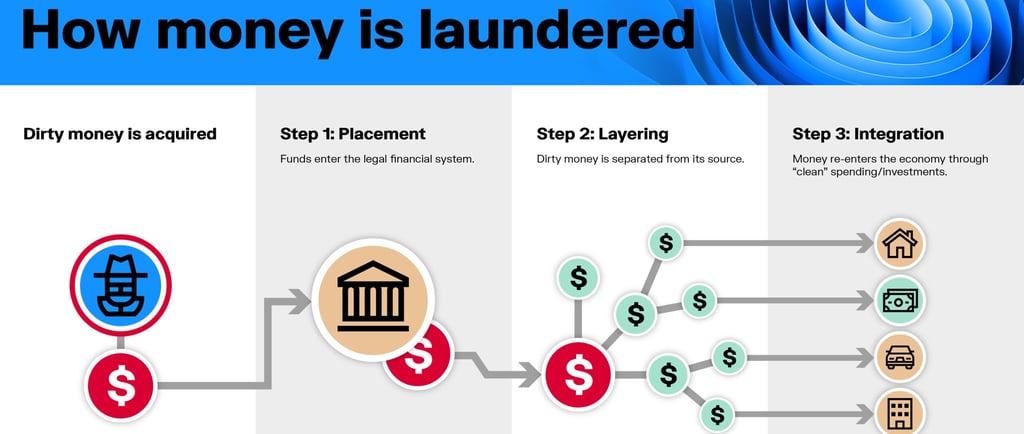Prevention of Money Laundering Act, 2002 (PMLA) — Comprehensive Summary
M.S. Husain, Advocate
10/7/20256 min read


Comprehensive Summary of PMLA
1. Overview and Objectives
[1] Purpose
Prevent and control money laundering in India.
Provide for confiscation of property derived from money laundering.
Establish mechanisms for investigation, attachment, adjudication, and prosecution.
Comply with international standards (e.g., FATF) on anti-money laundering and combating financing of terrorism (AML/CFT).
[2] Applicability
Applies to “proceeds of crime” arising from scheduled offences listed in the Schedule to PMLA.
Covers individuals, companies, partnership firms, NGOs, and other entities (including reporting entities like banks, financial institutions, intermediaries, and designated businesses).
2. Key Definitions
[1] Money Laundering (Section 3)
Directly or indirectly attempting to indulge, knowingly assisting, or being a party to activities connected with proceeds of crime, including concealment, possession, acquisition, use, or projecting/claiming as untainted property.
[2] Proceeds of Crime (Section 2(1)(u))
Any property derived or obtained, directly or indirectly, by any person as a result of criminal activity relating to a scheduled offence; includes equivalent value property held within India or abroad.
[3] Scheduled Offence
Predicate offences listed in the Schedule (IPC, NDPS, PMLA-related economic offences, corruption, tax-related customs offences, etc.). The Schedule is periodically amended.
3. Institutional Framework
[1] Enforcement Directorate (ED)
Investigates money laundering offences, conducts searches, seizures, arrests, and files complaints.
Executes attachment and confiscation in coordination with Adjudicating Authority and Special Courts.
[2] Financial Intelligence Unit–India (FIU-IND)
Receives, analyzes, and disseminates financial intelligence (STRs, CTRs, etc.) from reporting entities.
[3] Adjudicating Authority
Decides legality of provisional attachments and seizure of property/records by affording an opportunity to hearing to the parties.
[4] Special Courts (Designated under PMLA)
Try offences under section 3 and 4 and related matters; consider bail and conduct trials.
[5] Appellate Mechanism
Appeals qua attachment lie to the Appellate Tribunal (PMLA), then to High Courts.
Procedure lies under CrPC (now BNSS) shall be followed for Appeals qua prosecution.
4. Core Substantive Provisions
[1] Offence and Punishment (Sections 3–4)
Section 3 defines money laundering; Section 4 prescribes rigorous imprisonment (typically 3–7 years, up to 10 years for NDPS-linked laundering) and fine.
[2] Attachment and Confiscation (Sections 5, 8, 9)
Provisional attachment by ED if there is reason to believe that property is “proceeds of crime” and likely to be concealed/transferred.
Adjudicating Authority may confirm/ drop the attachment post-hearing; post-conviction, property can be confiscated or released.
Confiscation possible even if the property is held by third parties who are not bona fide purchasers for value.
[3] Search, Seizure, and Survey (Sections 16–18)
ED can conduct survey, search premises/persons, and seize records/assets subject to recorded reasons and statutory authorizations.
[4] Arrest (Section 19)
Authorized officers may arrest a person if there is reason to believe (recorded in writing) of guilt under PMLA; grounds of arrest to be informed as per law.
[5] Retention of Property/Records (Sections 20–21)
Seized items may be retained for investigation with Adjudicating Authority’s approval.
[6] Presumptions and Burden (Sections 22–24)
Presumption in interlinked records, and reversal of burden: accused must prove that alleged proceeds are untainted property once foundational facts are established by prosecution.
[7] Bail (Section 45)
Twin conditions (post-amendments and subject to court rulings):
Public prosecutor is given opportunity to oppose bail.
Court must be satisfied there are reasonable grounds to believe the accused is not guilty and not likely to commit any offence while on bail.
Certain categories (e.g., women, minors, sick/infirm) may have relaxations.
[8] Reporting Entities (Sections 2(1)(wa), 12)
Banks, financial institutions, intermediaries, and designated businesses must implement KYC, maintain records, report suspicious transactions (STR), cash transactions (CTR), and comply with client due diligence.
Enhanced due diligence for specified transactions; beneficial ownership identification.
[9] Corresponding Value and Foreign Property (Explanations to Section 2(1)(u))
Allows attachment/confiscation of equivalent value property in India where foreign proceeds are involved or property is held abroad.
[10] Continuation Despite Acquittal/Death (Sections 8, 58B–58F; amendments)
Confiscation and proceedings may continue in certain scenarios (e.g., if trial cannot be conducted due to death/absconding), subject to statutory safeguards.
5. Procedural Aspects and Safeguards
[1] Recording of “Reason to Believe”
Mandatory for attachment, search, seizure, and arrest; subject to judicial scrutiny.
[2] Supply of Grounds of Arrest
Must be furnished to the arrested person to enable meaningful challenge to detention/bail.
[3] Timelines
Provisional attachment typically valid for 180 days (subject to exclusions and confirmation).
Filing of complaint before Adjudicating Authority and Special Court within prescribed timelines.
[4] Cognizability and Non-bailability
PMLA offences are generally cognizable and non-bailable; ED officers have powers akin to police for specified purposes, but proceedings remain distinct from CrPC investigations.
6. Interaction with Predicate/Scheduled Offences
[1] Dependency on Scheduled Offence
Money laundering hinges on proceeds derived from a scheduled offence; however, courts have clarified when PMLA can proceed independently and the effect of acquittal/closure in predicate cases (see Judicial Pronouncements).
[2] Attachment without Prior FIR/Charge-sheet
ED may initiate based on material indicating proceeds of crime, even if police FIR/charge-sheet is pending or absent, provided a scheduled offence exists in substance.
7. Compliance Obligations for Reporting Entities
[1] KYC and Client Due Diligence
Verify identity, beneficial owners, and purpose/nature of relationship; maintain updated records.
[2] Record-Keeping
Maintain transaction records and identity documents for prescribed periods.
[3] Reporting to FIU-IND
File STRs, CTRs, cross-border wire transfer reports, and counterfeit currency reports as applicable.
[4] Enhanced Due Diligence
For high-risk customers, PEPs, non-face-to-face onboarding, and specified transactions.
[5] Internal Controls
Appoint Principal Officer/Designated Director, conduct employee training, independent audits, and implement risk-based AML programs.
8. Significant Judicial Pronouncements
[1] Vijay Madanlal Choudhary v. Union of India (2022)
Upheld core PMLA framework and 2019 amendments.
Validated:
Wide definition of money laundering (including “projecting as untainted”).
Twin bail conditions under section 45 (post-amendment).
ED’s powers of arrest, search, seizure, and attachment.
Clarified:
Supply of written grounds of arrest is necessary for meaningful bail rights.
PMLA proceedings are distinct from predicate offence investigations.
On predicate offences: if the person is finally discharged/acquitted of the scheduled offence or the case is quashed, ordinarily the ED case cannot survive due to absence of “proceeds of crime,” save limited exceptions.
[2] Nikesh Tarachand Shah v. Union of India (2017)
Initially struck down the pre-2018 twin bail conditions as unconstitutional.
Parliament amended section 45; later upheld in Vijay Madanlal (2022).
[3] Pankaj Bansal v. Union of India (2023)
Held that ED must furnish a copy of grounds of arrest in writing to the arrestee; oral communication is insufficient.
Non-supply vitiates custody, enabling release.
[4] Directorate of Enforcement v. Axis Bank & Ors. (Delhi HC, 2019)
Recognized ED’s powers to attach properties, including those with third parties, if traceable as proceeds of crime; bona fide third-party protections are narrow.
[5] Gautam Kundu v. Directorate of Enforcement (2015)
Affirmed ED’s powers, including statements recorded under PMLA and standards for arrest/search, subject to statutory compliance.
[6] Karti P. Chidambaram v. Directorate of Enforcement (various orders)
Clarified aspects of summons, appearance, and cooperation duties.
[7] Mohd. Arif v. Directorate of Enforcement; and recent High Court rulings
Emphasize judicial scrutiny of “reason to believe,” adherence to procedure, and proportionality in attachment.
Note: Courts frequently revisit PMLA’s procedural safeguards; practitioners should check the latest Supreme Court and High Court updates for evolving standards on statements under section 50, admissibility, and bail.
9. Amendments and Expanding Scope
[1] 2013–2019 Amendments
Broadened definition of money laundering and “proceeds of crime,” expanded Schedule, introduced “reporting entities” terminology, strengthened attachment/confiscation and ED powers.
[2] 2019 Finance Act Changes
Clarified that money laundering is a standalone, continuing offence.
Introduced explanations enabling attachment of equivalent value in India for foreign assets.
[3] Ongoing Notifications
Frequent updates to the Schedule and reporting obligations; entities must track RBI/SEBI/IRDAI and FIU-IND directions and PML Rules.
10. Practical Application and Enforcement Trends
[1] Focus Areas
High-value economic offences, corruption-linked laundering, NDPS-linked laundering, shell companies, foreign remittances, crypto/virtual assets, and trade-based laundering.
[2] Investigative Tools
Bank/account freezes, property attachments, summons under section 50, cross-border cooperation, and use of financial intelligence.
[3] Defence Considerations
Challenge the existence/quantum of “proceeds of crime.”
Scrutinize “reason to believe,” procedural lapses (search/arrest/attachment), and timelines.
Demonstrate bona fide acquisition for value without knowledge.
Engage with FIU/ED during investigation; maintain robust documentation.
[4] Compliance Best Practices (for Reporting Entities)
Risk-based AML program, transaction monitoring, beneficial ownership mapping, periodic KYC refresh, timely STRs, staff training, and board oversight.
11. Penalties and Consequences
[1] Criminal
Imprisonment under section 4 and fines; stringent bail regime.
[2] Civil/Regulatory
Monetary penalties on reporting entities and their officers for non-compliance with section 12 obligations.
Confiscation of property and freezing of accounts.
[3] Ancillary
Reputation risk, debarment from government contracts, regulatory actions by RBI/SEBI/IRDAI, and cross-border cooperation impacts.
12. Key Takeaways
[1] PMLA is a stringent, process-intensive statute with strong investigative powers and reversed burdens in parts.
[2] Establishing a clear link to “proceeds of crime” from a scheduled offence is central.
[3] Compliance culture and meticulous documentation are critical for entities; procedural safeguards are crucial for individuals.
[4] Supreme Court jurisprudence (especially 2022–2023) largely upholds PMLA’s architecture while insisting on procedural fairness (e.g., written grounds of arrest).
13. Quick Reference
[1] Section 3 : Offence definition : Concealment, possession, acquisition, use, projecting as untainted of proceeds of crime.
[2] Section 4 : Punishment : 3–7 years (up to 10 for NDPS) + fine.
[3] Section 5 : Attachment : Provisional attachment of proceeds of crime.
[4] Section 8–9 : Confirmation/Confiscation : Post-adjudication and conviction.
[5] Sections 16–18 : Search/Seizure/Survey : Powers with reasons to believe.
[6] Section 19 : Arrest : Written grounds; produced before court.
[7] Section 24 : Burden of proof : Accused to prove property is untainted once nexus shown.
[8] Section 45 : Bail : Twin conditions; limited relaxations.
[9] Section 12, PML Rules : Reporting duties : KYC, record-keeping, STR/CTR to FIU-IND.
[10] Section 26, 49 : Appeals to Appellate Tribunal and HC : Multi-tier appellate structure.
